Tuesday, April 8, 2025. Annette’s Roundup for Democracy.
The Fight Back.
Saturday happened. 3.5 million people protested.
Trump and the Press hardly noticed.
Big protests — but not big news - by Margaret Sullivan
On Sunday morning around 8 a.m., I scanned the home pages of some of the most influential news organizations in the United States, looking for coverage of the mass protests on Saturday. And I asked friends and relatives in various locations to tell me what their print newspapers had done with the story.
Quick answer: Not close to what it deserved.
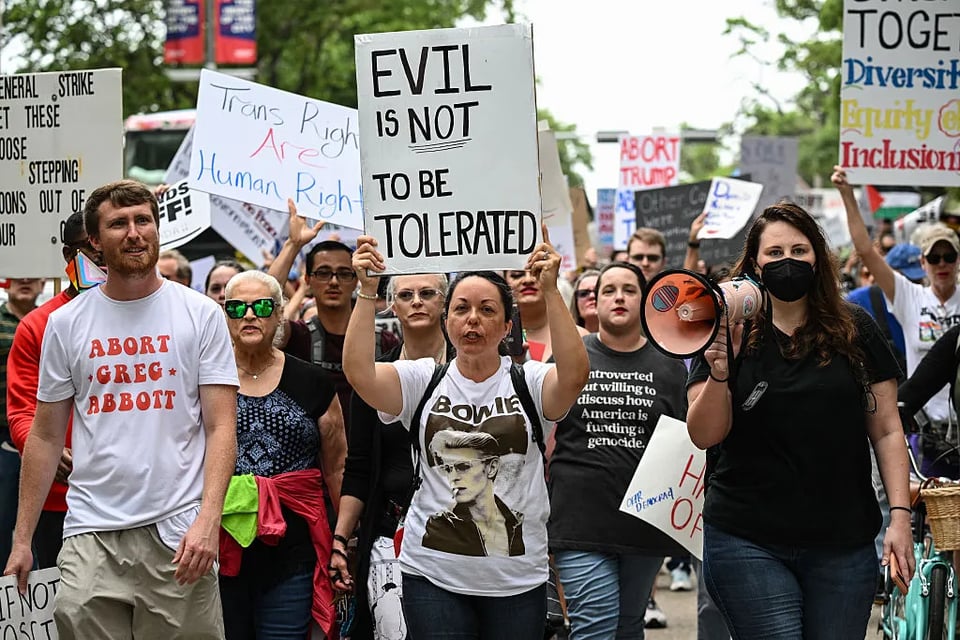
Demonstrators rally during the nationwide "Hands Off!" protest against Donald Trump and Elon Musk, in Houston, Texas, on Saturday. Despite large turnouts, the protests received tepid media coverage / Getty Images.
Here’s some of what I found:
In the Wall Street Journal, the story’s placement was the 20th most important. If you weren’t specifically looking for it, the coverage of 1,200 different protests in every state — and several in European cities — would not have caught your eye.
In the New York Times, the home page made it only the eighth most prominent. The main online photo was Trump at the White House with his fist raised. In the Times print edition, there was no article on Sunday front page; a smallish (two-column) photo, below the fold, carried a reference to a story inside the paper.
On the Fox News home page, I stopped counting after I scanned 40 articles and scrolled endlessly. I did see a video on Saturday, dismissively headlined, “Liberals rally against President Trump.”
The Washington Post and the Guardian found the story more important, as did CNN, which at one point on live TV had a banner headline: “MILLIONS OF PEOPLE PROTEST AGAINST TRUMP & MUSK.” They had live video from cities around the U.S.
The Washington Post didn’t put a story (only a teaser) on its Sunday front page in print. They placed it fourth on their Sunday morning home page — with a photo of big crowds in Salt Lake City, Utah. The Guardian US played it as their third most prominent article online. The Boston Globe and my hometown Buffalo News displayed their coverage inside the Sunday print paper, not on the front page. The Globe did give the story prominent display on the local section front, noting that 30,000 people had participated.
Organizers said that more than 100,000 demonstrators came to the protests in both New York and Washington DC. Crowd estimates are always tricky, but that certainly seems like a big story to me.
For weeks and months, I’ve been reading stories and analyses in major news organizations about how the public resistance to Trump is so much quieter now than in 2017.
But when the protests did happen, much of the media reaction was something between a yawn and a shrug. Or, in some outlets, a sneer.
Andy Revkin, the longtime environmental reporter, drew a sharp contrast with how the Times covered the first Earth Day demonstrations back in 1970 — with a huge six-column photograph at the top of the front page and a headline that shouted: Millions Join Earth Day Observances Across the Nation. A second headline: “Mood is Joyful as City Gives Its Support.” (Granted, this isn’t a perfect comparison, but the difference in tone is telling.)
The big question, for me, is why so much of the media downplayed the protests. I’ll offer three theories:
Although they wouldn’t phrase it the same way, many mainstream news organizations basically see this as Fox News does: Just the usual suspects — “liberals” — doing their thing. Nothing to see here, move along. I don’t believe that was the case; the crowds seemed to include people of many political stripes, drawn together by anxiety, fear and frustration with what’s been happening since Jan. 20th.
These media companies feared that prominent protest coverage would be criticized by the political right as partisan — in the tank for the anti-Trump forces. And they can’t take the terrible risk of being a part of that. In other words, the refs have been successfully worked. Again.
They don’t want to aggravate (or lose) right-leaning readers and viewers. They seek a big tent at all costs. So, yes, they seem to say, we will cover this, but we will downplay it. That quiet tone, they seem to say, is the best bet for not antagonizing anyone. (Margaret Sullivan, Substack).
BREAKING: The group behind the MASSIVE “Hands off” protest is now calling for another protest on April 19.
— Brian Krassenstein (@krassenstein) April 7, 2025
In social media posts, the group stated that they want 3.5 percent of the U.S. population—more than 11 million people—to participate. They cite this figure as the threshold… pic.twitter.com/6dvmnO2X0D
Well, the deranged man Trump noticed a little bit.

Universities start to fight back.
Harvard is getting set for the fight.
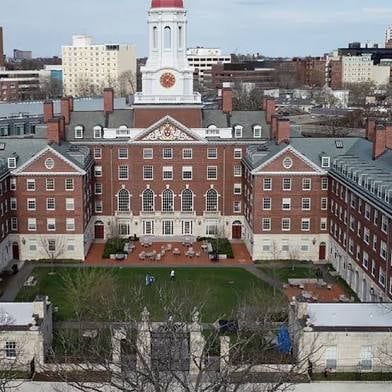
Harvard to Borrow $750 Million After Warning of Funding Threat.
(Bloomberg) -- Harvard University plans to borrow $750 million from Wall Street amid mounting threats to its federal funding from the Trump administration.
“As part of ongoing contingency planning for a range of financial circumstances, Harvard is evaluating resources needed to advance its academic and research priorities,” a spokesperson for Harvard said in an emailed statement on Monday when asked about the bond sale.
The debt will be taxable, and proceeds will be used for general corporate-purposes, according to bond documents. Goldman Sachs Group Inc. is the sole bookrunner on the transaction.
Schools across the US are bracing for potential funding hits after President Donald Trump escalated scrutiny of colleges accused of mishandling allegations of antisemitism on campuses, threatening to revoke billions of dollars in federal aid. The administration has frozen funding for Columbia and Princeton universities, while Harvard faces potential losses of as much as $9 billion in grants and contracts unless it complies with a list of federal demands.
To prepare for the uncertainty, some schools have tapped short-term borrowing to preserve cash. Selling taxable bonds, which have a more flexible use of proceeds than traditional tax-exempt debt, is another option to shore up liquidity.
For colleges, it’s a “strategic and very fiscally astute decision to shore up any liquidity that they have due to the extreme uncertainty,” said Lisa Washburn, a managing director at Municipal Market Analytics. She said she wouldn’t be surprised to see more colleges tap the taxable market.
Princeton University is also considering the sale of taxable bonds. The school announced last week that US government agencies have suspended dozens of its research grants.
Harvard warned investors about the federal funding threat in its bond documents.
“While the financial impact on the university of any developments at the federal level cannot be quantified at this time, they may, directly or indirectly, have a material adverse effect on the current and future financial profile and operating performance of the university,” Harvard said in its bond documents dated April 6.
While Harvard is the richest US college with a $53 billion endowment, it’s highly dependent on federal funding, especially for its research operation. In offering documents, the school said it has historically received “substantial” support for research from Washington, a sum that totaled 11% of operating revenues in the fiscal year that ended June 30. (Bloomberg).
One more thing.
AI gave some numbers on Jews as a % of the American population, and of the population of Ivy League colleges.
https://www.perplexity.ai/search/59e8eef4-9bec-42ef-8841-f01f0fa8f533Cornell University has the largest Jewish undergraduate population among Ivies, with 2,500 students (15.6% of its student body), followed by Brown University (23.9%, 1,700 students) and Columbia University (22.5%, 1,500 students). However, other Ivies like Harvard and Princeton have seen declines, with Jewish populations now below 10%.
Approximately 2.4% of the U.S. population is Jewish, equating to about 7.5 million people as of recent estimates. This includes both adults who identify as Jewish by religion and those who are secular or culturally Jewish.
The President of Wesleyan is leading the fight for universities.
Trump Is Selling Jews a Dangerous Lie by Michael Roth, President of Wesleyan University

Taking a break from her work dismantling her own department, Secretary of Education Linda McMahon last week threatened roughly $9 billion of grants and contracts with Harvard because of “the school’s failure to protect students on campus from antisemitic discrimination.” As shocking as that threat was, it wasn’t entirely a surprise: Since the Justice Department convened its Task Force to Combat Antisemitism, 60 universities have received notice that they are being monitored or investigated.
With an administration seemingly determined to do everything, everywhere, all at once, discerning its true priorities can sometimes be challenging. But on this one point, Donald Trump wants no ambiguity: “My promise to Jewish Americans is this,” he said on the campaign trail. “With your vote, I will be your defender, your protector, and I will be the best friend Jewish Americans have ever had in the White House.”
As the first Jewish president of a formerly Methodist university, I find no comfort in the Trump administration’s embrace of my people, on college campuses or elsewhere. Jew hatred is real, but today’s anti-antisemitism isn’t a legitimate effort to fight it. It’s a cover for a wide range of agendas that have nothing to do with the welfare of Jewish people.
All of these agendas — from dismantling basic government functions to crushing the independence of cultural and educational organizations to criminalizing political speech to legitimating petty presidential vendettas — endanger the principles and institutions that have actually made this country great. For Jews, a number of these agendas do something more: They pose a direct threat to the very people they purport to help. Jews who applaud the administration’s crackdown will soon find that they do so at their peril.
Among the first high-profile targets of the anti-antisemitic push have been a recent Columbia graduate and a current Tufts University graduate student, one a lawful permanent resident of this country and the other one here on a student visa, who spoke out in favor of Palestinian rights. Both have been handcuffed, driven off and indefinitely detained. Neither has been charged with a crime.
Abductions by government agents; unexplained, indefinite detentions; the targeting of allegedly dangerous ideas; lists of those under government scrutiny; official proclamations full of bluster and bile — Jews have been here before, many times, and it does not end well for us. The rule of law and the right to freedom of thought and expression are essential safeguards for everyone, but especially so for members of groups whose ideas or practices don’t always align with the mainstream. As M. Gessen recently wrote in these pages, “A country that has pushed one group out of its political community will eventually push out others.” What our government is doing now is wrong in itself, but beyond that, it poses a bigger threat to Jewish people’s safety than all the campus protests ever could.
I’ve received a trove of emails asking whether Jews are welcome at Wesleyan. In my (lucky) 18th year as Wesleyan’s president, I am pleased to tell them that Shabbat dinners are well attended, the Israeli Film Festival is offering excellent cultural fare and Jewish studies courses — one on the archetype of the Jewish mother, taught by an Israeli — are oversubscribed. Of course we’ve had protests, with Jews on both sides of them. Some of the students having grown up in communities of like-mindedness are surprised there is more than one side of an issue. In some cases, that is enough to awaken their anxieties.
The situation was different at Columbia. Protests became violent (both in the actions of the participants and those of the police who were called in to quell them). Tensions between supporters of Palestinians and Israelis were at times extreme. In the pages of The Atlantic, Franklin Foer recently documented some serious antisemitic activity. All of which is presumably why Columbia was the first to be singled out by the forces of anti-antisemitism.
But in other ways, Columbia is an odd choice. It has the second highest percentage of Jewish students in the Ivy League. Secretary McMahon has said the government is canceling $400 million of federal support for the school because of its failure to protect Jewish students. Federal cuts to Columbia, however, will disproportionately affect Jewish students.
And when the White House announced the cuts, it did so with a tweet that said “SHALOM COLUMBIA.” You don’t have to be Jewish to hear a large measure of sarcasm in those words.
That kind of tension — between championing Jews and ridiculing, reviling, or in some cases even threatening them — has been visible on the right for some time. Consider first the president: On the one hand, his daughter, son-in-law and grandchildren are Jewish. (Ivanka Trump converted to Judaism when she married Jared Kushner.) On the other hand, when neo-Nazis, Klansmen and others marched through Charlottesville, Va., carrying torches and shouting “Jews will not replace us,” Mr. Trump condemned the most extreme elements of the rally but observed that there were “some very fine people on both sides.”
A “Severance”-level disconnect between an image of Jews as both vulnerable people who must be protected and powerful people who must be defeated, is now widespread. Last year when Congress drew up a bill to oppose antisemitic speech on college campuses, many legislators raced to voice their support. But not some of MAGA’s most prominent representatives, including Matt Gaetz and Marjorie Taylor Greene, who had no objection to fighting antisemitism but observed that the language of the bill would interfere with Christians’ ability to accuse Jews of killing Christ. At other times, agreeing with Vladimir Putin, she has said that the Jewish president of Ukraine was running “a Nazi army.”
The prominent Trump supporter Candace Owens has said that Jeffrey Epstein was working for Israel, a nation that has gotten blackmail “down to a science.” The MAGA hero (and subject of sex trafficking charges) Andrew Tate has encouraged people to “question” their criticism of Hitler — and to bring back the Nazi salute, while they’re at it — and said that “the people who wrote the official story” of the Holocaust “have used it to subvert the consciousness of Western populations into mass genetic suicide.”
Elise Stefanik, the third-ranking House Republican, has ferociously defended Jews against antisemitism in higher education, leading intense questioning of three university presidents, two of whom soon after lost their positions. In other settings, however, she has used language similar to the “great replacement theory,” the same xenophobic conspiracy theory that the Unite the Right participants in Charlottesville were chanting about.
Nick Fuentes, who had dinner with Mr. Trump in 2022, lists “the influence of Jews” as one of the two biggest problems in the world, and announced that “Talmudic Jews” have to leave the country or be converted. As for Mr. Trump himself, he declared that Senator Chuck Schumer is “not Jewish anymore,” which reminded me of Karl Lueger, a raging antisemite and fin-de-siècle mayor of Vienna, who declared, “I decide who is a Jew.” Leo Terrell, the head of Mr. Trump’s antisemitism task force, shared a tweet by a prominent white supremacist that lauded the president’s “ability to revoke someone’s Jew card.”
As Oscar Hammerstein II put it in “The King and I”: “If allies are strong with power to protect me/Might they not protect me out of all I own?” These are our defenders? SHALOM, indeed.
In the Long Island town where I grew up, Jews were a minority. My father taught me how to punch antisemites before getting hit — when I was in elementary school! And he emphasized to me that I should expect to encounter such people wherever I went, especially as I moved into unfamiliar professional or social settings.
Today I encounter many young Jews who are shocked by anti-Israel attitudes (even from fellow Jews, part of the long history of Jewish antizionism). They are shocked by how many progressives decry ethnostates but somehow mention only Israel, or how readily people, when given half a chance, will express what the historian Deborah Lipstadt has called “clueless” antisemitism. Political events seem to expand their license to do so. If you feel righteous about being an anti-colonialist, why worry about a little antisemitism? Like the white supremacists liberated by mainstream anti-D.E.I. language, these antisemites hear perfectly legitimate criticism of, say, the Israeli government, and regard it as an opportunity to unfurl the true extent of their prejudice.
The novelist and scholar Dara Horn has speculated that as the memory of Nazis and the Holocaust dimmed, “the public shame associated with expressing antisemitism was dying too — in other words, hating Jews was normal.” Which means we should expect things to get even worse.
Given all this, there is a great temptation for Jews to embrace anyone who denounces antisemitism, regardless of the moral contradictions (or the dubious connection between protecting religious minorities and, say, cutting grants for cancer research). “We appreciate the Trump Administration’s broad, bold set of efforts to counter campus antisemitism,” the Anti-Defamation League said in response to the detention of Mahmoud Khalil, the legal permanent resident, “and this action further illustrates that resolve by holding alleged perpetrators responsible for their actions.”
As Sam Adler-Bell has recently noted, some American Jewish organizations have encouraged the erosion of rights and norms in exchange for support for Israel. The president hadn’t been in office a full day before the ADL spoke up to defend Elon Musk for throwing what sure looked to me like a Sieg Heil. After weathering intense criticism over its support for Mr. Khalil’s abduction, the organization’s chief executive last week restated the need for due process. How did we get to the point where that’s even in doubt?
The ADL was founded in 1913, in the wake of the case of Leo Frank, a Jewish man accused of murdering a 13-year-old Christian girl. Most historians today agree that Frank, who was lynched in 1915, was wrongly convicted after a sham trial, but the MAGA folks on X can’t help but celebrate the lynching of a Jew. “He got exactly what he deserved,” exclaimed Lauren Witzke, a 2020 Republican Senate nominee, “and everyone in that crowd should have received medals for protecting their community.”
Kingsley Wilson, the 20-something deputy press secretary at the Pentagon, praised the far-right party Alternative for Germany by invoking the Nazi slogan “Ausländer raus!” (“Foreigners out!”). As the traditional conservatives at Bulwark put it, “The ‘vibe shift’ is not necessarily that more people on the right are antisemites compared to eight years ago, but that much of the right now appears to reject the basic notion that there should be any stigma against even the vilest bigotry.”
That’s why the “instrumentalization of Jewish fear” is so pernicious. Those who attack people like Mahmoud Khalil today will be breaking bread with the “Ausländer raus!” folks tomorrow. They will seek new targets. Who’s next?
In the second and first century B.C., the Jewish kingdom of Judea aligned itself with Rome to protect itself from the domination of Greek culture. Rome obliged, and conquered Judea for itself. The enemy of our enemy was not our friend. There’s a lesson there, if we can heed it.
Here’s another, from the Pirkei Avot, a compilation of rabbinical ethical teachings: “Be cautious with governments, for they bring a person close to them only for their own needs. They appear as friends when it benefits them, but they do not stand by a person in his time of difficulty.” Some Jewish people feel gratified to hear the president say he’ll defend us, but today’s ruling authorities will not be good for the Jews. (Op-Ed, The New York Times).
Republicans like to cut taxes, but they haven't spoken out until today against Trump’s tariffs, the taxes destroying America.
Michael Bloomberg, an “off again, on again” Republican, may catch some one’s attention.👇
America Is Headed for a Grim Fiscal Reckoning

Congress should be alarmed by the CBO’s new debt projections. Instead, it’s aiming for bigger budget deficits.
Amid all the blaring headlines coming out of Washington, here’s a piece of news that is getting far too little attention: The US is on course for fiscal breakdown. That’s the unambiguous message from the Congressional Budget Office’s newly updated long-term projections. Unless Congress changes course, there’ll be a reckoning, and it will be grim.
As the CBO details, deficit spending is more out of control than ever. Both parties share the blame, as do both ends of Pennsylvania Avenue. And all should remember that investors’ appetite for US government debt isn’t limitless.
The federal government is currently spending roughly $7 trillion and collecting only $5 trillion in taxes annually. The resulting deficit is a little over 6% of gross domestic product, a disturbingly high number for an economy around full employment.
The CBO expects public borrowing to remain at this elevated level or higher for decades. Assuming no recessions, public debt will rise to 100% of GDP this year and 118% by 2035 — and it just keeps rising from there.
A responsible Congress would make deficit reduction its overriding priority. Instead, Republicans are discussing ways to borrow more — and not just a little more. New tax cuts are under consideration. And many want to extend provisions of the 2017 Tax Cuts and Jobs Act, which would otherwise expire at the end of this year.
Extending the law in full would increase the national debt by roughly $5 trillion over the next decade and $40 trillion over 30 years. The debt ratio in 30 years would soar to more than 200% of GDP.
Higher tariff revenues won’t come close to balancing the books. In fact, the impact on overall revenue is likely to be negative, because tariffs depress commercial activity and job creation.
Savings from slashing the federal payroll won’t have any appreciable effect, either. For all the media attention generated by cuts to personnel and programs — and some of them are warranted — they are having almost no impact on restraining the budget deficit.
Making matters worse, the mass layoffs and program cuts are being made without concern for the delivery of public services that voters depend on. When they see that public parks are closed, health care is declining and deaths from infectious disease are becoming more common, they’ll be angry.
Republicans may pay a steep price when the midterm elections roll around next year, but regardless: The current approach to governing isn’t tenable in the long run. At some point, long before the debt reaches stratospheric heights, financial markets — if not voters — will say enough is enough. Bond prices will collapse, long-term interest rates will spike and the government will default — either explicitly or behind the cloak of surging inflation.
Restoring fiscal control should be job No. 1 for this Congress. The only sensible approach is to combine moderate tax increases and judicious cuts in spending. Spreading the burden would allow the changes to be more palatable and gradual, if they’re undertaken soon.
Elements of the Tax Cuts and Jobs Act are worth preserving: The bigger standard income-tax deduction and stronger investment incentives, for example, are pro-growth. But all such extensions, and any other new measures, should be more than matched by lower spending and higher taxes overall, to deliver a substantial net reduction in projected deficits.
Congress has already delayed too long, but the cost of delaying further — and worse, compounding the problem with additional deficit spending — will have devastating economic consequences.
In Washington, the biggest scandals are often hiding in plain sight. Unless Congress and the administration get serious about deficit reduction, Americans will soon see the costs pile up around them. (Bloomberg).
Today, more Republicans joined the Grassley-Cantwell bill to re-assert the Congress’s authority over tariffs.
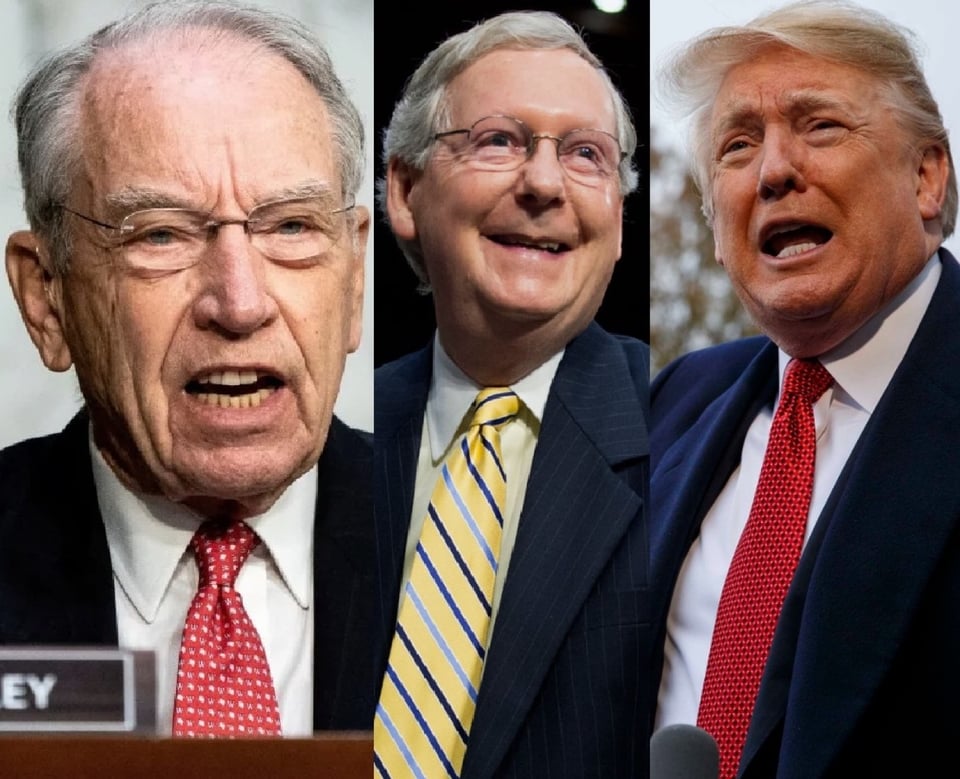
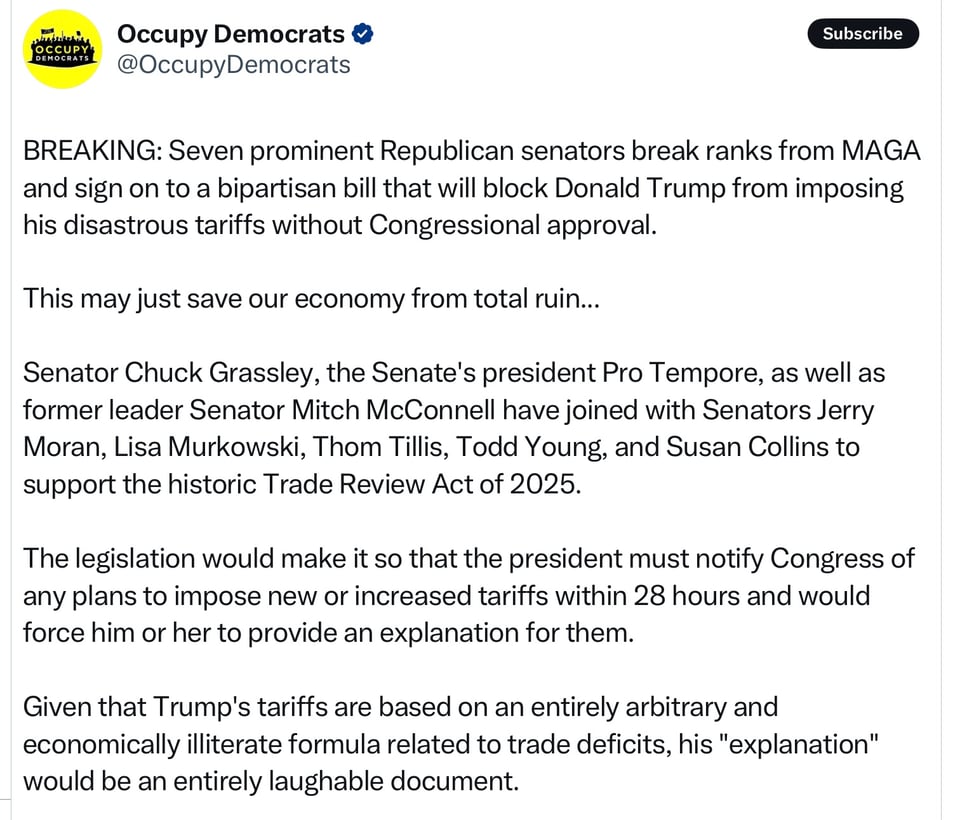
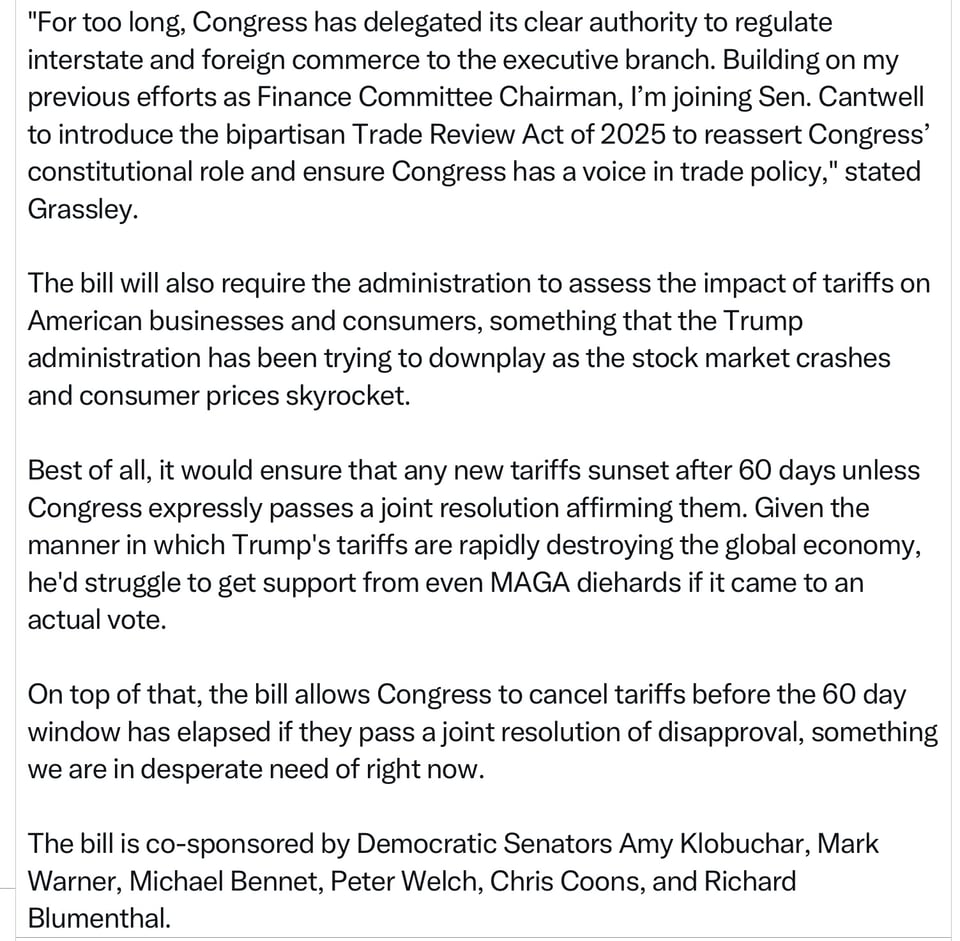
FYI. The Trump White House has already stated that it "strongly opposes" the bill, which is exactly how you know that it's good for America.
Other MAGA defectors are happening too.
More surely will follow.
This is a big fish.👇
BREAKING: In an unprecedented moment, Fox News' Maria Bartiromo is no longer able to deny reality, finally admitting to viewers that Trump's tariff policies will lead to an American recession. This is huge.pic.twitter.com/Howfe5Kv6H
— Really American 🇺🇸 (@ReallyAmerican1) April 7, 2025
Some memes and some headlines are too important to resist.
The Economist: “Donald Trump has committed the most profound, harmful, and unnecessary economic error in the modern era. Almost everything he said—on history, economics and the technicalities of trade—was utterly deluded” pic.twitter.com/1Cx5hbHgSj
— Republicans against Trump (@RpsAgainstTrump) April 3, 2025

Wow. The Toronto Star this morning. We've lost Canada. pic.twitter.com/RawmaspTDR
— Victor Shi (@Victorshi2020) April 7, 2025